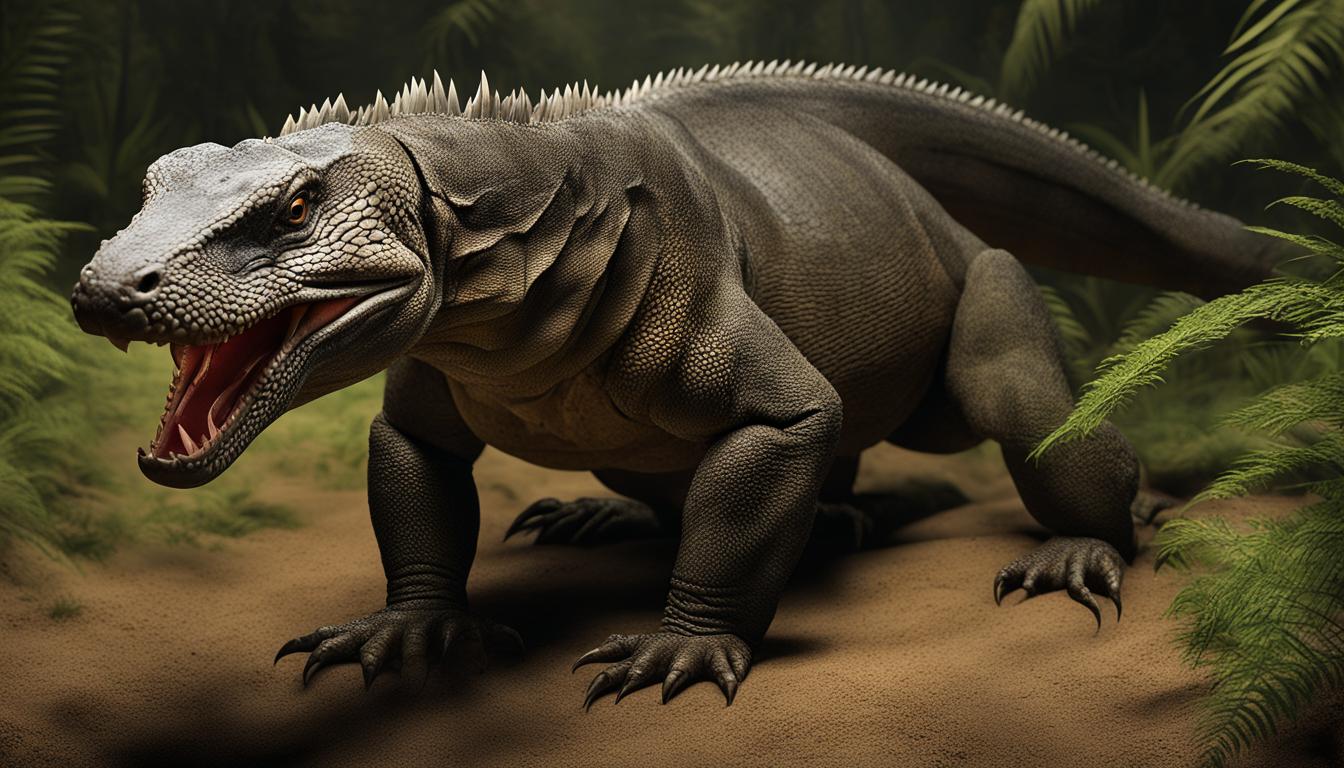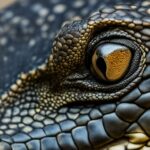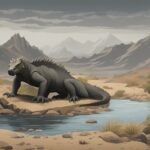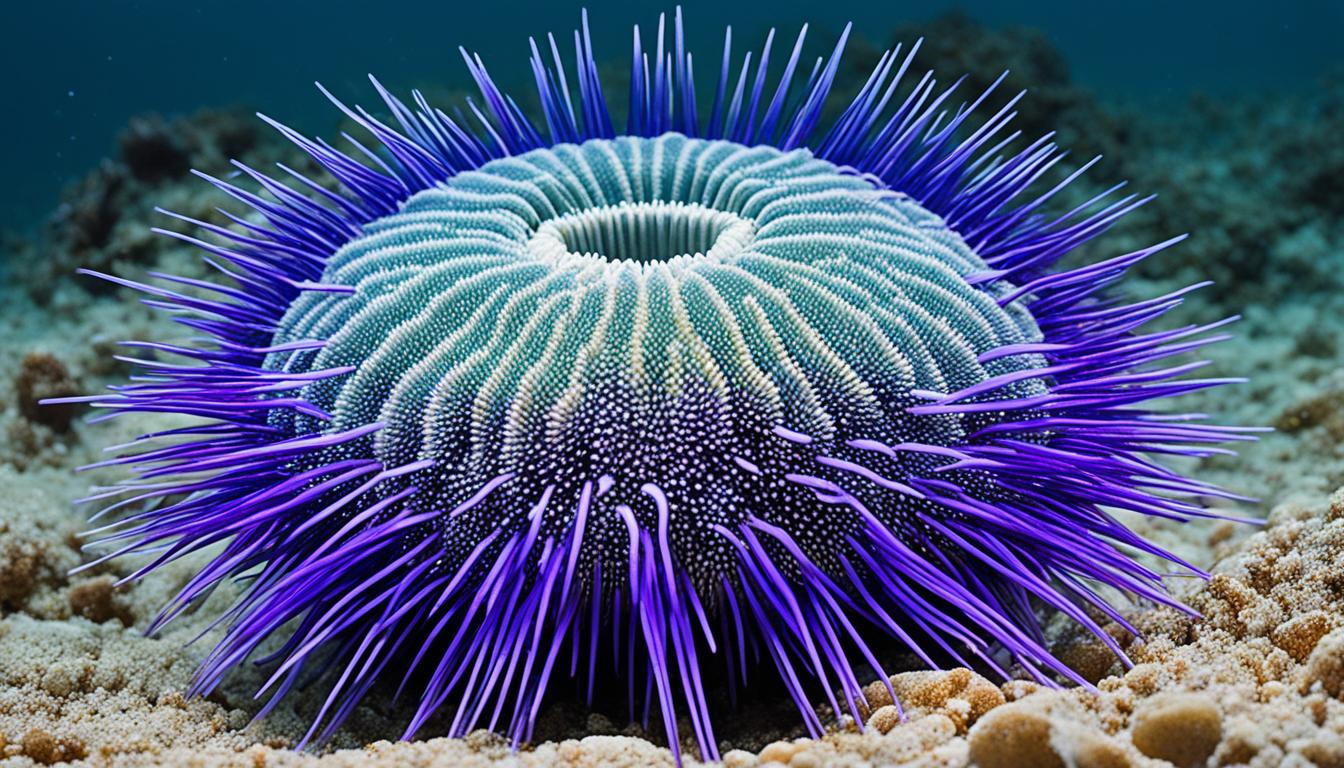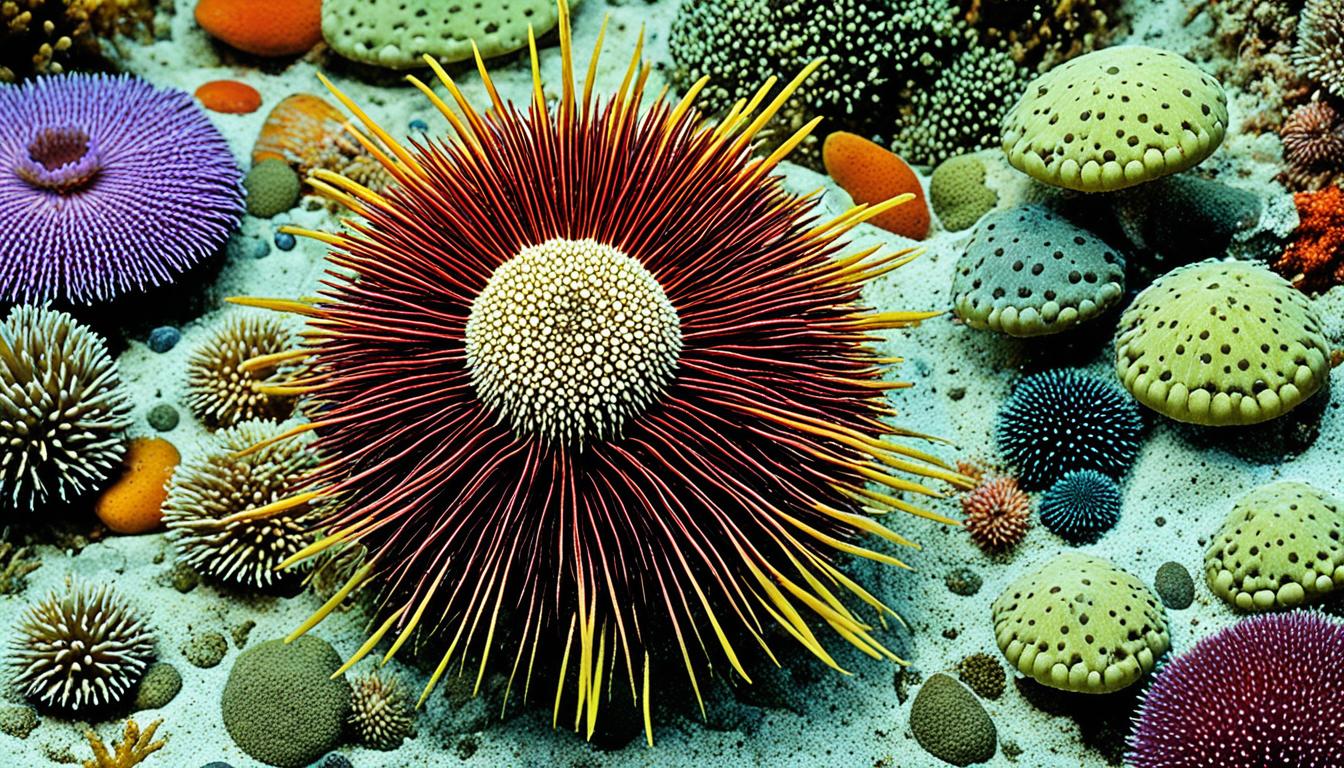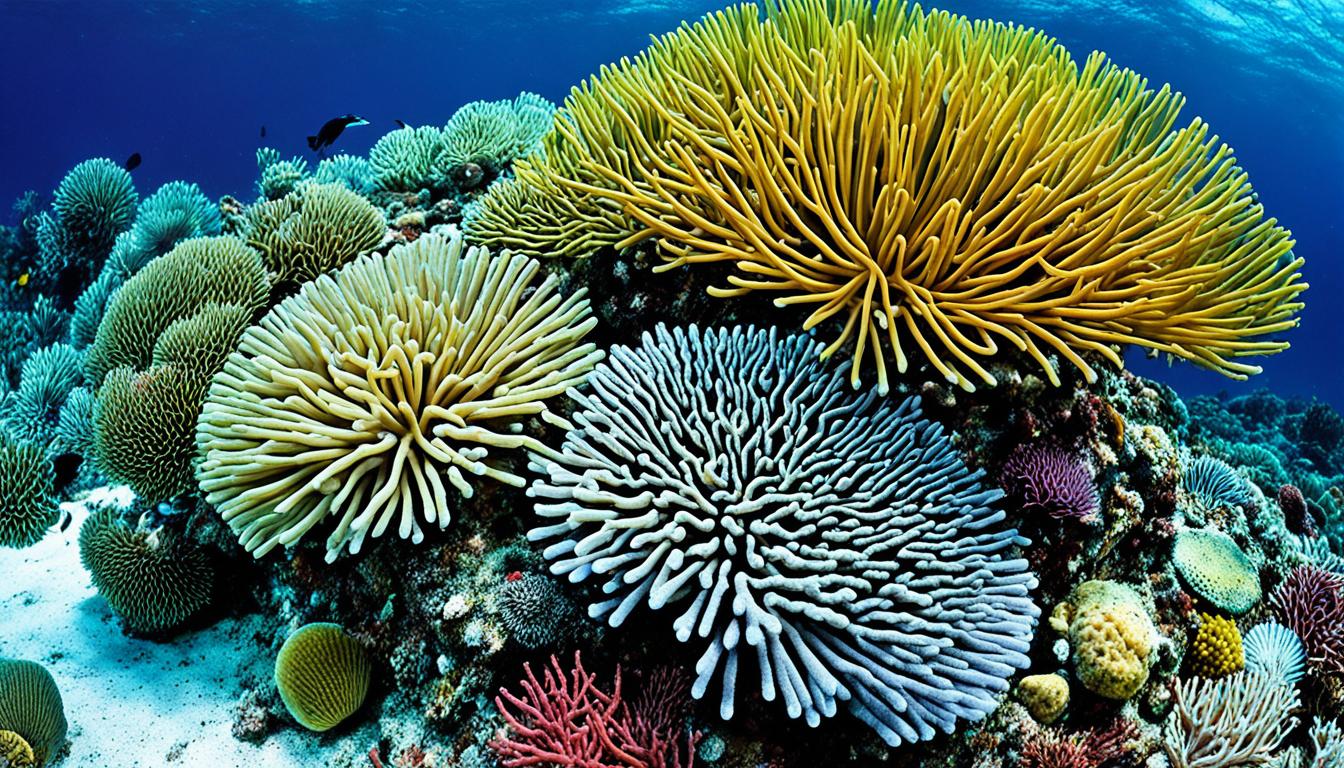Welcome to our exciting journey into the world of the Komodo dragons! These incredible creatures possess a set of unique features that make them truly extraordinary. From their imposing size and strength to their impressive hunting techniques and fascinating reproductive abilities, Komodo dragons are a marvel of nature.
With their long, flat heads, scaly skin, and robust bodies, Komodo dragons stand out amongst other species. They can grow up to 10 feet in length and weigh around 330 pounds, making them the largest lizards on Earth. Their physical characteristics, combined with their distinct behaviors and habitats, contribute to their status as one of the most captivating creatures in the animal kingdom.
Join us as we delve into the mesmerizing world of Komodo dragons. Discover their habitats, hunting techniques, diets, and size, as well as their venomous capabilities and astonishing lifespan. We’ll also explore the conservation efforts dedicated to protecting these magnificent reptiles and ensuring their future survival.
Get ready to uncover the unique features of Komodo dragons, as we embark on a journey filled with wonder and awe!
Komodo Dragon Habitat and Behavior
Komodo dragons, also known as Varanus komodoensis, are fascinating creatures that have adapted to thrive in their unique habitats. These incredible reptiles can be found in the harsh climate of Indonesia’s Lesser Sunda Islands, specifically in the lush tropical forests. The dense vegetation of these forests provides the perfect cover for Komodo dragons, allowing them to blend seamlessly with their surroundings.
These formidable predators typically stay close to their home territories but have been known to cover distances of up to seven miles per day in search of food and mates. They are patient hunters, relying on their exceptional camouflage to lie in wait for unsuspecting prey. Once a suitable victim approaches, the Komodo dragon strikes with lightning speed, using their sharp claws and serrated teeth to eviscerate their prey.
“Komodo dragons are expert ambush predators, using their impressive size and strength to overpower their prey. They are truly the masters of their environment.”
With their impressive size and strength, Komodo dragons have become the dominant predators in their habitats. They are known to take down a wide range of prey, including carrion, deer, pigs, smaller dragons, and even large water buffalo. Their hunting techniques, combined with their unique physical characteristics, make them truly remarkable creatures.
| Unique Habitat Features | Behavioral Traits |
|---|---|
| Thrive in tropical forests | Stay close to home territory |
| Blend seamlessly with surroundings | Cover distances up to seven miles per day |
| Utilize camouflage for hunting | Patience as an ambush predator |
Summary:
Komodo dragons inhabit the tropical forests of Indonesia’s Lesser Sunda Islands, relying on their exceptional camouflage to hunt and survive. With their unique physical characteristics, including sharp claws and serrated teeth, these reptiles have become the dominant predators in their environments. Their ability to patiently wait for their prey and cover long distances in search of food and mates showcases their remarkable behavioral traits.
Komodo Dragon Diet and Hunting Techniques
When it comes to their diet, Komodo dragons are opportunistic predators that will eat almost anything they come across. Their menu includes carrion, deer, pigs, smaller dragons, and even large water buffalo. These formidable creatures have a hunting strategy that relies heavily on both stealth and agility.
Komodo dragons are skilled ambush predators. They patiently lie in wait for passing prey, blending into their surroundings with their impressive camouflage. When the moment is right, they pounce on their unsuspecting victim, using their powerful bite and sharp teeth to incapacitate it. This is where their hunting technique takes an even more deadly turn.
“The Komodo dragon’s bite is not only powerful, but it also contains venom,” explains Dr. Jane Summers, a renowned reptile expert. “Their venom glands inject toxins into the prey’s bloodstream, causing a drop in blood pressure, massive bleeding, prevention of clotting, and inducing shock. This combination of factors accelerates the loss of blood and ultimately leads to the prey’s demise.”
Table: Komodo Dragon Diet
| Prey | Prey Type |
|---|---|
| Carrion | Decaying flesh of animals |
| Deer | Small to medium-sized ungulates |
| Pigs | Mammals typically weighing up to 100 pounds |
| Smaller Dragons | Juvenile or smaller Komodo dragons |
| Large Water Buffalo | Ungulates weighing over 1,000 pounds |
This unique combination of hunting techniques sets Komodo dragons apart from other predators. Their stealth and agility, combined with their deadly venom, make them incredibly efficient hunters in their natural habitat.
As we delve deeper into the world of Komodo dragons, there is still much more to discover. In the next section, we will explore the fascinating topic of Komodo dragon reproduction and learn about the incredible ways in which these reptiles perpetuate their species.
Komodo Dragon Reproduction
Reproduction plays a crucial role in the life cycle of Komodo dragons. These majestic creatures reproduce once a year, with a unique and fascinating process that ensures the continuation of their species. Female Komodo dragons release a scent in their feces to attract potential mates, signaling their readiness to reproduce. This scent acts as a powerful aphrodisiac, drawing male dragons from miles away.
When a male dragon detects the scent, he starts his journey to locate the female. Upon finding her, the mating ritual begins. The male gently scratches and licks the female’s body, initiating physical contact to determine her receptiveness. If she reciprocates the behavior, they can proceed to mate. This mating ritual is a delicate dance of communication and courtship between the male and female dragons.
After successful mating, the female Komodo dragon will lay a clutch of approximately 30 eggs. She carefully buries the eggs in the ground to protect them from predators and harsh environmental conditions. The incubation period lasts around eight months, with the temperature of the nest determining the gender of the hatchlings. Warmer temperatures produce male dragons, while cooler temperatures result in females. This temperature-dependent sex determination is a unique aspect of Komodo dragon reproduction.
Interestingly, Komodo dragons also have the ability to reproduce asexually through a process called parthenogenesis. This occurs when a female dragon’s eggs develop and hatch without being fertilized by a male. Parthenogenesis ensures that female dragons can potentially produce offspring even in the absence of viable mates, allowing for genetic diversity and the survival of the species under specific circumstances.
Nest Location and Protection
During the nesting period, female Komodo dragons choose specific locations to lay their eggs. These nesting sites are carefully selected for their temperature suitability and protection. The female digs a hole in the ground, often near suitable vegetation or in the vicinity of other nests. This communal nesting behavior provides additional protection for the eggs and reinforces the social structure among the dragons.
While the nest provides initial protection, the survival of the hatchlings is not guaranteed. Female Komodo dragons do not provide parental care, and once the eggs hatch, the hatchlings must fend for themselves. Only a few of the hatchlings will reach maturity due to predation and other environmental factors, making their journey from nest to adulthood a challenging and perilous one.
| Key Points | Details |
|---|---|
| Reproduction Cycle | Once a year |
| Mating Behavior | Male licks and scratches female’s body |
| Egg Clutch Size | Approximately 30 eggs |
| Incubation Period | Around 8 months |
| Sex Determination | Temperature-dependent |
| Asexual Reproduction | Through parthenogenesis |
Komodo Dragon Size and Weight
Komodo dragons are renowned for their impressive size and weight, distinguishing them as the largest lizards on Earth. These incredible creatures can reach lengths of up to 10 feet (3 meters) and weigh approximately 330 pounds (150 kilograms). To put their size into perspective, imagine standing next to a 6-foot (1.8 meters) tall man – a Komodo dragon would tower over him, showcasing its dominance as the heaviest lizard species.
Such substantial proportions are a testament to the Komodo dragon’s evolutionary adaptations, enabling them to thrive in their native habitat of Indonesia’s Lesser Sunda Islands. Surrounded by tropical forests and challenging environments, these reptiles have evolved to become true giants of the reptile world.

The King of Lizards
With their size and weight, Komodo dragons possess an unparalleled presence in their ecosystem. Their robust bodies, fortified with powerful muscles, allow them to navigate their surroundings with ease. This remarkable size grants them the ability to take down formidable prey such as deer, pigs, and even large water buffalo, solidifying their status as apex predators in their habitat.
| Length | Weight |
|---|---|
| Up to 10 feet (3 meters) | Around 330 pounds (150 kilograms) |
As you can see, the table above summarizes the size and weight of Komodo dragons. It provides a clear comparison to assert their dominance in the reptile kingdom.
“Komodo dragons are truly awe-inspiring creatures, with their immense size and weight making them an iconic species. Their ability to grow to such lengths and weigh hundreds of pounds showcases their unparalleled strength and adaptability in their environment.”
– Reptile Enthusiast Magazine
Now that we’ve explored the incredible size and weight of Komodo dragons, we will delve into another fascinating aspect of these reptiles in the next section.
Komodo Dragon Venom
One of the most intriguing features of Komodo dragons is their venomous bite. Unlike other venomous creatures that use their venom for quick immobilization, Komodo dragons have a more complex venomous effect. When a Komodo dragon bites its prey, the venom causes a drop in blood pressure, leading to massive bleeding and prevention of clotting. This leads to shock and accelerates the loss of blood, eventually resulting in the prey’s death.
The venom of the Komodo dragon contains various toxins that work together to incapacitate their victims. The exact composition and function of the venom are still being studied by scientists. It is believed that the venom contains proteins that disrupt blood clotting and promote bleeding. The venom also has antimicrobial properties, which may help prevent infection in the dragon’s mouth, considering the unsanitary conditions in which they feed.
The presence of venom in Komodo dragons is a recent discovery, as it was previously believed that their bite was lethal due to bacteria present in their saliva. However, further research has determined that the venom plays a significant role in the hunting process of these apex predators. The unique venomous bite of Komodo dragons highlights their remarkable adaptation and adds to their status as fascinating creatures.
In conclusion, the venom of Komodo dragons is a formidable weapon used in their hunting strategy. The complex effects of their venom, including the disruption of blood clotting and induction of shock, contribute to the successful capture and consumption of their prey. The study of Komodo dragon venom continues to provide valuable insights into the fascinating adaptations of these iconic reptiles.
Komodo Dragon Lifespan
The lifespan of Komodo dragons in the wild is approximately 30 years. However, with the protection and care provided in captivity, these remarkable creatures can live even longer. Captive Komodo dragons have been known to reach ages of 40 years or more, making them an incredible sight to behold.
It is important to note that the lifespan of Komodo dragons can vary depending on various factors, including the availability of food, habitat quality, and overall health. In the wild, Komodo dragons face challenges such as competition for resources, predation, and environmental changes that can impact their lifespan.
Conservation efforts play a vital role in ensuring the longevity of Komodo dragons. By protecting their natural habitats and raising awareness about the importance of these creatures, we can help secure their future. The establishment of protected areas like Komodo National Park in Indonesia has been instrumental in safeguarding their habitat and allowing these fascinating reptiles to thrive.
Comparison of Lifespan
| Species | Average Lifespan |
|---|---|
| Komodo Dragon (Varanus komodoensis) | 30 years (wild); 40+ years (captivity) |
| African Elephant (Loxodonta africana) | 60-70 years |
| Tiger (Panthera tigris) | 10-15 years (wild); 16-20 years (captivity) |
| Galapagos Giant Tortoise (Chelonoidis nigra) | 100+ years |
As seen in the table above, the lifespan of Komodo dragons is relatively shorter compared to some other iconic species. However, it is important to recognize that each species has unique characteristics and adaptations that contribute to their lifespan. The Komodo dragon’s ability to survive and thrive in its specific habitat showcases its remarkable resilience and adaptability.
Komodo Dragon Conservation Efforts
Protecting the future of Komodo dragons is crucial, as they face numerous threats that endanger their survival. Conservation efforts are underway to preserve these incredible creatures and their unique habitat.
Threats to Komodo Dragon Survival
Komodo dragons are currently facing a range of challenges that impact their population. Habitat loss due to deforestation and climate change restricts their living space and disrupts their natural environment. Human activities, such as poaching and disturbance of their mating process by tourists, further contribute to the decline in their numbers.
| Threats to Komodo Dragon Survival | Conservation Efforts |
|---|---|
| Habitat loss | Establishment of protected areas, such as Komodo National Park, to preserve their natural habitats. |
| Poaching | Increased patrols and collaborations with local communities to prevent illegal hunting and trafficking. |
| Disruption of mating process by tourists | Raising awareness about responsible tourism and implementing regulations to minimize disturbances during the mating season. |
These threats highlight the urgent need for conservation efforts to safeguard the future of Komodo dragons.
“The protection and preservation of Komodo dragons not only ensure the survival of a unique species but also contribute to the overall biodiversity and ecological balance of their habitat.”
Through the establishment of protected areas, increased enforcement against poaching, and education about responsible tourism, conservationists are working to mitigate the risks faced by these remarkable creatures. By supporting these efforts, we can help secure a future where Komodo dragons continue to thrive.

Conservation of Komodo Dragons
Komodo dragons, being a unique and iconic species, require dedicated conservation efforts to ensure their survival. These reptiles face numerous threats, including habitat loss, human activities, and disruption of their mating process. To protect these magnificent creatures and their habitats, Indonesia established the Komodo National Park in 1980.
Spanning over 700 square miles, the park serves as a haven for Komodo dragons and aims to prevent poaching while raising awareness about the importance of conservation. Through regular patrols and collaborations with local communities, the park actively works towards safeguarding the future of these fascinating reptiles.
Conservation initiatives go beyond protecting their habitats. Institutions like the ABQ BioPark also play a vital role in the preservation of Komodo dragons. These institutions actively participate in Species Survival Plans (SSPs) to maintain genetic diversity among captive dragons. They provide comprehensive care, including enrichment activities and simulated natural environments, to cater to the physical and mental needs of these remarkable reptiles.
| Conservation efforts for Komodo dragons: | Impact |
|---|---|
| Establishment of Komodo National Park | Provides protected habitat for Komodo dragons, preventing poaching and raising awareness. |
| Participation in Species Survival Plans | Maintains genetic diversity among captive dragons, ensuring the long-term survival of the species. |
| Enrichment activities and simulated natural environments in captive institutions | Promotes the physical and mental well-being of Komodo dragons in captivity. |
Conservation efforts play a crucial role in securing the future of Komodo dragons. By protecting their natural habitats, raising awareness, and providing comprehensive care in captivity, we can ensure that these unique creatures continue to thrive for generations to come.
Komodo Dragons in Captivity
When it comes to preserving the remarkable Komodo dragons, captivity plays a vital role. Institutions like the ABQ BioPark provide a safe haven for these majestic creatures, where they are cared for and studied. One of the key initiatives in captive Komodo dragon management is the Species Survival Plan (SSP), which ensures the genetic diversity of these reptiles.
Within these facilities, enrichment activities are carried out to meet the physical and mental needs of the Komodo dragons. Simulated natural environments are created to mimic their natural habitat, allowing them to exhibit their natural behaviors and thrive. These efforts not only contribute to the well-being of captive dragons but also offer educational opportunities for visitors to learn about their unique characteristics.
“Our primary goal is to educate the public about the importance of Komodo dragons and the need for their conservation. By showcasing these magnificent creatures in a controlled environment, we can raise awareness about their role in the ecosystem and inspire people to take action,” says Dr. Elizabeth Martinez, a reptile expert at the ABQ BioPark.
Through captive breeding programs, researchers and conservationists hope to bolster the population of Komodo dragons. These programs aim to ensure the long-term survival of the species by creating a sustainable and genetically diverse population. By monitoring and studying the behavior, reproduction, and overall health of the dragons in captivity, valuable insights can be gained to support conservation efforts both in captivity and in the wild.
Table: Captive Komodo Dragon Population by Institution
| Institution | Number of Komodo Dragons |
|---|---|
| ABQ BioPark | 8 |
| San Diego Zoo | 6 |
| Smithsonian National Zoo | 4 |
| Toronto Zoo | 3 |
| Melbourne Zoo | 2 |
While captive populations of Komodo dragons play an essential role in conservation, the ultimate goal is to protect their natural habitat and ensure their survival in the wild. Continued efforts to conserve and restore their native ecosystems are necessary to safeguard their future and maintain the balance of these unique reptiles within the ecosystem.
Conclusion
Komodo dragons are truly remarkable creatures, possessing a variety of unique features that set them apart from other species. From their impressive size and strength to their stealthy hunting techniques and fascinating reproductive abilities, these reptiles have adapted to thrive in their specific habitats.
However, the survival of Komodo dragons is under threat. Their natural habitats are shrinking due to climate change and human activities, while poaching and disruption of their mating process by tourists further endanger their populations. It is crucial that conservation efforts are in place to protect these incredible creatures and raise awareness about their importance.
Through the establishment of protected areas like Komodo National Park, efforts are being made to safeguard the future of Komodo dragons. These initiatives work to prevent poaching, preserve their habitats, and promote public education about their unique behaviors and habitats. By supporting these conservation efforts and spreading awareness, we can ensure the long-term survival of these magnificent reptiles for generations to come.
What Are Some Unique Features of Komodo Dragon Habits?
The secrets of komodo dragon habitation are fascinating. These reptiles have a unique and solitary lifestyle. They exhibit cannibalistic tendencies, as adults often prey on juveniles. Female Komodo dragons can reproduce without a male through a process called parthenogenesis. Their saliva contains harmful bacteria, enabling them to deliver deadly bites to their victims, facilitating efficient hunting.
FAQ
What is the size of a Komodo dragon?
Komodo dragons can grow up to 10 feet in length and weigh around 330 pounds.
Where do Komodo dragons live?
Komodo dragons thrive in the harsh climate of Indonesia’s Lesser Sunda Islands, specifically in tropical forests.
What do Komodo dragons eat?
Komodo dragons have a varied diet and will eat almost anything they encounter, including carrion, deer, pigs, smaller dragons, and even large water buffalo.
How do Komodo dragons hunt?
Komodo dragons rely on their stealth and agility when hunting. They ambush their prey and use their powerful bite, sharp teeth, and venom glands to incapacitate and consume their victims.
How do Komodo dragons reproduce?
Female Komodo dragons release a scent in their feces to attract males. Mating occurs when a male scratches and licks the female’s body, and if she reciprocates, they mate. Females lay around 30 eggs, burying them in the ground until they hatch eight months later. Interestingly, female dragons can also reproduce asexually through a process called parthenogenesis.
How big can Komodo dragons get?
Komodo dragons can reach lengths of up to 10 feet and weigh around 330 pounds. In comparison to a 6-foot man, a Komodo dragon is significantly larger and more robust, emphasizing their dominance as the heaviest lizards on Earth.
Do Komodo dragons have venom?
Yes, Komodo dragons possess venom glands loaded with toxins. When they bite their prey, the venom causes a drop in blood pressure, massive bleeding, prevention of clotting, and induces shock. The venom accelerates the loss of blood and eventually leads to the prey’s death.
How long do Komodo dragons live?
In the wild, Komodo dragons have an average lifespan of up to 30 years. However, with the protection and care provided in captivity, they can live even longer.
What are the threats to Komodo dragons?
Komodo dragons face threats such as habitat loss, poaching, and disruption of their mating process by tourists. These factors have negatively impacted their population.
How are Komodo dragons conserved?
Conservation efforts, such as the establishment of Komodo National Park in Indonesia, aim to protect these reptiles and raise awareness about their importance. The park works through patrols and collaborations with local communities to prevent poaching and protect their habitat.
Where can I see Komodo dragons?
Some institutions, like the ABQ BioPark, house Komodo dragons for educational and conservation purposes. These facilities take part in Species Survival Plans (SSPs) to ensure the genetic diversity of captive dragons.

